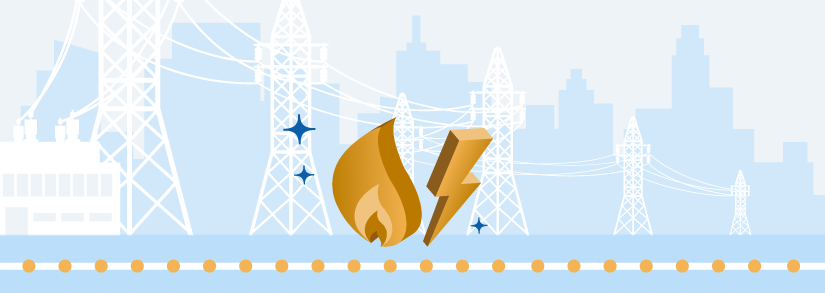National Grid UK: What is it & How does it work?

National Grid owns and operates electricity and gas transmission networks across Great Britain. Read on to learn about how it ensures energy is delivered safely and efficiently to your home, as well as discover what other services National Grid offers.
What is the National Grid?
National Grid is an energy utility company that operates in both the United Kingdom and the United States. It was founded in 1990 in London, England.
In the UK, National Grid owns the following three separate network businesses:
- National Grid Electricity Transmission (ET): National Grid ET owns the high-voltage electricity network in England and Wales.
- National Grid Electricity System Operator (ESO): National Grid ESO operates the electricity system in Great Britain. It uses the infrastructure owned by Britain’s three transmission networks (one of which is National Grid ET) to move electricity across the country, balancing supply and demand in real-time.
- National Grid Gas Transmission (GT): National Grid GT both owns and operates the high-pressure gas transmission system in Great Britain.
In addition to its network businesses in the UK, National Grid also operates various ventures, which include the following:
- Electricity interconnectors: This plays a critical role in the transition to renewable energy sources. By 2024, electricity interconnectors will import enough energy to power eight million homes. By 2030, 90% of the electricity imported via National Grid’s interconnectors will come from zero-carbon sources.
- Renewable energy: On a mission to accelerate the development of clean energy, National Grid has invested in large-scale renewable projects, such as wind, solar and battery storage.
- Competitive transmission: Using its ability to deliver large-scale transmission assets, National Grid competes for large-scale energy transmission projects across the UK.
- Future developments: To create value for its customers, partners and shareholders, National Grid focuses on future opportunities, such as clean energy innovation, offshore wind, and carbon capture and storage.
- Metering: National Grid provides gas meter installation and maintenance services to energy suppliers in Great Britain
National Grid share price
The investor-owned company is one of the largest publicly traded energy companies in the world. The National Grid share price peaked in July 2016 at 1,130 GBP. Over the past year, the share price peaked at 1,067.40 GBP in February. It dropped by 25% in March 2020 to an annual low of 799.70 GBP as the nation went into lockdown in response to the coronavirus pandemic.
As of 17 May 2020, the current National Grid share price sits at 930.80 GBP.
National Grid News
- In 2017, National Grid sold off its gas distribution business to a consortium of investors. National Grid Gas Distribution has since rebranded as Cadent Gas.
- In April 2019, National Grid Electricity Transmission became a legally separate company within the National Grid Group.
- In June 2020, National Grid ESO announced it went a record 67 days, 22 hours and 55 minutes without using electricity generated from coal. This two-month run marked the longest period that Britain had gone without coal since 1882.
National Grid Electricity Transmission
National Grid Electricity Transmission (ET) owns and maintains the high-voltage electricity transmission network in England and Wales.
It is responsible for ensuring that electricity is transported efficiently and safely from where it is produced (at a power plant, wind farm, etc.) to the area’s local distribution networks, which then distribute it to homes and businesses across their network area.
The National Grid ET network consists of 4,481 miles of overhead lines, 1,416 miles of underground cables and 347 substations.
Once electricity has been generated, National Grid Electricity Transmission then increases its voltage (so that less energy is lost in transport) and carries it along its network of overhead lines and underground cables to a substation.
At the substation, the electricity then passes through a transformer, which reduces the voltage to a level safe for residential use. National Grid Electricity Transmission then passes the electricity on to local distribution networks to deliver to homes and businesses.

It’s likely that you’ll never need to contact National Grid Electricity Transmission, except for the following reasons:
- If you have an energy project that you need to get connected to the transmission network in England or Wales.
- If you’re working near National Grid Electricity Transmission assets, such as transmission lines or cables.
If you experience a power cut or need a new electricity connection for your home or business, you should call your distribution network operator (DNO) rather than National Grid Electricity Transmission.
The different distribution networks are run by the following six DNOs:
- Electricity North West
- Northern Powergrid
- SP Energy Networks
- Scottish and Southern Electricity Networks (SSEN)
- UK Power Networks
- Western Power Distribution
National Grid ESO

National Grid Electricity System Operator (ESO) moves electricity from where it is generated to where it is needed across Great Britain, balancing supply and demand every second of the day.
Operators in the National Grid ESO control room work to maintain the frequency and voltage of the system at stable levels. This involves making immediate decisions to ensure that the exact amount of electricity being consumed matches the amount being generated.
National Grid ESO moves over 730 GWh of high-voltage electricity around the country every day – which is enough to power 146 billion light bulbs. To move this high-voltage electricity across Britain, the system operator uses the infrastructure owned by the following three electricity transmission companies:
- National Grid Electricity Transmission
- Scottish Hydro Electric Transmission
- SP Energy Networks
This high-voltage electricity is then passed on to your local distributor, and the voltage is reduced to make it safe for domestic use.
National Grid Future Energy Scenarios
Each year, National Grid ESO publishes its Future Energy Scenarios (FES). These different scenarios represent credible ways to decarbonise the UK’s energy system as it aims to become carbon neutral by 2050.
To develop the Future Energy Scenarios, energy experts from National Grid ESO work together with stakeholders and other industry experts to analyse and develop realistic scenarios for energy in the UK. By developing multiple scenarios, they claim they can better understand the uncertainties facing the industry.
The latest Future Energy Scenarios publication (from July 2020) includes four scenarios. All but one of the scenarios reach the net-zero target by 2050.
In analysing the four scenarios, experts developed the following four key messages:
- In order to reach net-zero carbon emissions by 2050, immediate action is required across all key policy and technology areas, as well as across society.
- Hydrogen production and carbon capture and storage (CCS) must be utilised to reach net zero.
- The energy market must fundamentally shift. Markets must provide incentives for zero-carbon generation.
- Open data and digitalisation are critical to helping the UK reach net zero emissions by 2050.
You can find the latest Future Energy Scenarios publication on the National Grid ESO website.
National Grid Gas Transmission

National Grid Gas Transmission owns and operates Britain’s gas transmission network, which is also known as the National Transmission System (NTS).
This network of gas pipelines carries high-pressure gas from the producers (who extract it from deep underground) across the country to local distributors. The local gas distributors then lower the pressure and deliver it to your home.
In addition to transporting high-pressure gas, National Grid Gas Transmission must also balance gas supply with daily demand. In forecasting demand, National Grid must consider a range of factors that can contribute to a change in gas demand, such as weather patterns. The company publishes a forecast for the next day on a daily basis at 1 p.m.
For the average gas consumer, around 1.6% of your annual gas bill goes to National Grid Gas Transmission in exchange for running and maintaining the transmission network.
National Grid Gas Connections
National Grid Gas Transmission provides gas connections to large end-users, such as industrial consumers, power stations and DNOs. The company does not provide gas connections for homes or SMEs (small and medium-sized businesses). For this service, you will need to contact your local gas distributor, which is one of the four following companies:
- Cadent gas
- SGN
- Northern Gas Networks
- Wales & West Utilities
National Grid Gas Distribution
National Grid Gas Distribution rebranded as Cadent Gas in 2017 when National Grid sold off its majority stake of the gas distribution business to a group of investors.
Cadent Gas delivers gas to 11 million homes and businesses across the North West, West Midlands, East of England and North London.
You can contact what is now known as Cadent Gas (rather than National Grid) by calling 0800 389 8000. Reasons you may need to contact your gas distributor include the following:
- To connect your home or business to the gas network
- To have your gas meter moved
- To have gas pipes on your property relocated
- To register for the Priority Services Register (you can also do this through your supplier)
If you smell gas, you should immediately call the National Gas Emergency line on 0800 111 999.
National Grid Metering

National Grid Metering is a subsidiary of National Grid. It provides gas metering and meter reading services to energy suppliers in Great Britain.
Suppliers contract National Grid to provide and install gas meters for their customers. National Grid metering currently owns around nine million gas assets (such as meters) across Britain.
For the domestic gas industry, National Grid Metering services include the following:
- Meter installation, maintenance, exchange and removal
- Customer service provision and support
- Asset procurement and logistics management
If you have a general enquiry about your gas meter, you should first contact your gas supplier. Your supplier is also whom you should call to arrange a meter installation. If you need to apply for a new gas connection or want your gas meter relocated, you should call your local gas distributor.
If neither service is able to help you, you can then call National Grid Metering on 0800 001 4340.
National Grid power cut
If you experience a power cut, you should not contact National Grid. You should instead contact your distribution network operator (DNO). If you’re not sure who your DNO is or how to contact them, you can dial 105. This line is free to call and open 24 hours a day, seven days a week.
In the case of a power cut, we advise you to also take the following action (if possible):
- See if other areas are affected. You can either ask your neighbours or check the street lights.
- Turn off electrical appliances that should not be left unattended. This includes irons and other devices that may cause harm if they restart when the power comes back on.
- Check the trip switch in your fuse box. If it is not in the on position, turn off all electrical appliances and attempt to reset the switch.
- Don’t open your freezer. If left unopened, some freezers can remain cold for up to 12 hours! In the case that your food spoils, you may even be able to file a claim on your home insurance.
- Check on your vulnerable neighbours. See that they are warm and have sufficient food supplies.
Jobs & Careers
Are you interested in applying for a job at National Grid? The company says it offers the opportunity for you to “make a real impact” while at work.
To find current job vacancies, go to the National Grid homepage and scroll down to the bottom. Under where it says Work for us, click on Careers UK. Next, scroll down to the blue button that says Visit UK careers.
The National Grid site also includes videos of current employees to help you discover more about what they do on a daily basis.
To find out about what positions are recruiting right now, you can also send an email to [email protected].
Contact
Need to contact National Grid? You can find the contact information for its head office in the table below.
| Contact Method | Contact Detail |
|---|---|
| Phone number | +44 (0)20 7004 3000 |
| Mailing address | National Grid, 1-3 Strand, London WC2N 5EH |
Got a power cut? Call 105 to inform your electricity distributor.
Smell gas? Call the National Gas Emergency line on 0800 111 999 immediately.
